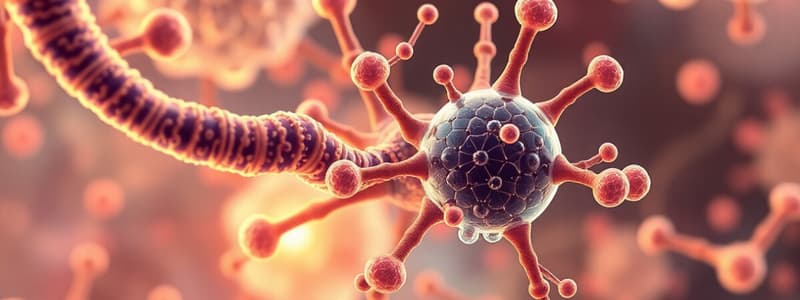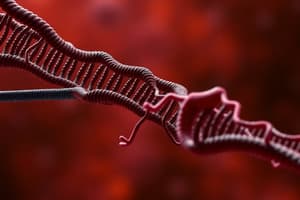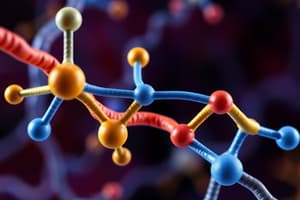Podcast
Questions and Answers
What is the primary function of receptors in cell signaling?
What is the primary function of receptors in cell signaling?
- To transport nutrients into the cell.
- To regulate the cell's energy production.
- To provide structural support to the cell membrane.
- To recognize and respond to extracellular molecules. (correct)
Receptors are typically lipid macromolecules inserted across the lipid bilayer of the cell.
Receptors are typically lipid macromolecules inserted across the lipid bilayer of the cell.
False (B)
What two main functions do receptors perform?
What two main functions do receptors perform?
Recognition/detection; transduction
Receptors interact with specific chemicals, such as __________ and neurotransmitters, with a high degree of specificity.
Receptors interact with specific chemicals, such as __________ and neurotransmitters, with a high degree of specificity.
Match the terms with their descriptions:
Match the terms with their descriptions:
What does the term 'affinity' refer to in pharmacology?
What does the term 'affinity' refer to in pharmacology?
Receptors are named or classified based on the antagonists they bind to.
Receptors are named or classified based on the antagonists they bind to.
How do pharmacologists utilize the specificity of drug-receptor interactions?
How do pharmacologists utilize the specificity of drug-receptor interactions?
A plot of the proportion of receptors occupied versus drug concentration [D] is a __________.
A plot of the proportion of receptors occupied versus drug concentration [D] is a __________.
Match the affinity level with its corresponding $K_D$ value:
Match the affinity level with its corresponding $K_D$ value:
What does a low $K_D$ value indicate?
What does a low $K_D$ value indicate?
The $K_D$ is a measure of how quickly a drug binds to a receptor.
The $K_D$ is a measure of how quickly a drug binds to a receptor.
What is the difference between drugs that merely bind to a receptor and agonists?
What is the difference between drugs that merely bind to a receptor and agonists?
Agonists bind to receptors and then _________ the receptor, leading to a biological response.
Agonists bind to receptors and then _________ the receptor, leading to a biological response.
Match the type of agonist with its characteristic:
Match the type of agonist with its characteristic:
What distinguishes a full agonist from a partial agonist?
What distinguishes a full agonist from a partial agonist?
Partial agonists have high efficacy and are very effective at producing a biological response.
Partial agonists have high efficacy and are very effective at producing a biological response.
What term describes drugs that inhibit the effects of a neurotransmitter or hormone?
What term describes drugs that inhibit the effects of a neurotransmitter or hormone?
__________ antagonists compete with agonists for the same binding site on a receptor.
__________ antagonists compete with agonists for the same binding site on a receptor.
Match the type of antagonism with its definition:
Match the type of antagonism with its definition:
Which form of antagonism involves one drug chemically inactivating another?
Which form of antagonism involves one drug chemically inactivating another?
Non-competitive antagonists bind to the same site on the receptor as the agonist, but their effects are irreversible.
Non-competitive antagonists bind to the same site on the receptor as the agonist, but their effects are irreversible.
In what way are the effects of reversible competitive antagonists overcome?
In what way are the effects of reversible competitive antagonists overcome?
Reversible competitive antagonists cause a __________ shift to the right in the agonist log concentration vs response curve.
Reversible competitive antagonists cause a __________ shift to the right in the agonist log concentration vs response curve.
Match the effect on the agonist log concentration vs response curve with the type of antagonist:
Match the effect on the agonist log concentration vs response curve with the type of antagonist:
What effect do irreversible competitive antagonists have on the agonist log concentration-response curve?
What effect do irreversible competitive antagonists have on the agonist log concentration-response curve?
The effects of irreversible competitive antagonists can be overcome by increasing the concentration of the agonist.
The effects of irreversible competitive antagonists can be overcome by increasing the concentration of the agonist.
What is the distinction between the effects of reversible versus irreversible competitive antagonists on the log concentration-response curve for agonists?
What is the distinction between the effects of reversible versus irreversible competitive antagonists on the log concentration-response curve for agonists?
Drugs with high affinity hit the “sweet spot” on the receptor and stay bound for a relatively long time i.e. they have a slow __________.
Drugs with high affinity hit the “sweet spot” on the receptor and stay bound for a relatively long time i.e. they have a slow __________.
Why is the $EC_{50}$ for an agonist often NOT the same as the concentration required to occupy 50% of the available receptors ($K_D$)?
Why is the $EC_{50}$ for an agonist often NOT the same as the concentration required to occupy 50% of the available receptors ($K_D$)?
Adrenaline causes a significant conformational change in its receptor, despite being the size of a large protein.
Adrenaline causes a significant conformational change in its receptor, despite being the size of a large protein.
Two drugs, 'A' and 'B', act on the same receptor. Drug 'A' has a $K_D$ of 100 nM, and drug 'B' has a $K_D$ of 10 microM. Which drug has the higher affinity for the receptor?
Two drugs, 'A' and 'B', act on the same receptor. Drug 'A' has a $K_D$ of 100 nM, and drug 'B' has a $K_D$ of 10 microM. Which drug has the higher affinity for the receptor?
The inhibitory effects of reversible competitive antagonists can be overcome by increasing the concentration of the __________.
The inhibitory effects of reversible competitive antagonists can be overcome by increasing the concentration of the __________.
A drug produces a non-parallel shift in the agonist log concentration-response curve. What type of antagonist is most likely responsible?
A drug produces a non-parallel shift in the agonist log concentration-response curve. What type of antagonist is most likely responsible?
If a drug has high affinity for a receptor, it will always have high efficacy as well.
If a drug has high affinity for a receptor, it will always have high efficacy as well.
Flashcards
What are Receptors?
What are Receptors?
Protein macromolecules usually inserted across the lipid bilayer of the cell that bind certain chemicals.
What are the 2 main functions of receptors?
What are the 2 main functions of receptors?
Receptors perform two main functions: recognition/detection of extracellular molecules and transduction of these molecules into changes in cell activity.
How are receptors classified?
How are receptors classified?
Receptors are often named or classified based on the drugs they bind, utilizing the specificity of interaction between drug and receptor.
What is K
D (dissociation constant)?
What is K D (dissociation constant)?
Signup and view all the flashcards
What does the K
D measure?
What does the K D measure?
Signup and view all the flashcards
What do agonists do?
What do agonists do?
Signup and view all the flashcards
What does 'Efficacy' describe?
What does 'Efficacy' describe?
Signup and view all the flashcards
Full vs. Partial Agonists
Full vs. Partial Agonists
Signup and view all the flashcards
What do Full Agonists often do?
What do Full Agonists often do?
Signup and view all the flashcards
What is an Antagonist?
What is an Antagonist?
Signup and view all the flashcards
Forms of Antagonism
Forms of Antagonism
Signup and view all the flashcards
Competitive Antagonists
Competitive Antagonists
Signup and view all the flashcards
Non-competitive antagonists
Non-competitive antagonists
Signup and view all the flashcards
Reversible competitive antagonists
Reversible competitive antagonists
Signup and view all the flashcards
What Effect Do Reversible Competitive Antagonists have?
What Effect Do Reversible Competitive Antagonists have?
Signup and view all the flashcards
Irreversible competitive antagonists
Irreversible competitive antagonists
Signup and view all the flashcards
Study Notes
Receptor Basics
- Receptors are protein macromolecules inserted across the cell's lipid bilayer.
- Receptors perform two main functions: recognizing extracellular molecules and transducing signals to change cell activity.
- Receptors bind specific chemicals like hormones or neurotransmitters with high specificity.
- Receptors are named or classified based on the drugs that bind to them.
- Nicotinic acetylcholine receptors bind acetylcholine and the exogenous drug nicotine.
- Pharmacologists design drugs to target specific receptor subtypes in different cells, leading to more selective drugs with fewer side effects.
Drug Binding and Affinity
- Drug (D) binding to a receptor (R) is typically reversible, represented as D + R ⇌ DR.
- A plot of the proportion of receptors occupied (p) against drug concentration [D] forms a rectangular hyperbola.
- A plot of the proportion of receptors occupied (p) against log [D] forms a symmetrical sigmoid curve.
- Affinity is quantified as the molar concentration of a drug required to occupy 50% of receptors at equilibrium, denoted as KD.
- High affinity drugs have a low KD, often in the micro (10^-6) or nano (10^-9) molar range.
- KD represents the equilibrium dissociation constant.
- k+1 and k-1 are rate constants indicating the likelihood of forward and backward reactions.
- At equilibrium, the backward rate equals the forward rate.
- KD is a measure of how tightly a receptor holds onto a drug once they come together.
- Receptors are continually bombarded by chemicals, but only those with high affinity bind strongly.
- High affinity drugs (low KD) bind for a relatively long time due to a slow dissociation rate (k-1 is very small).
Agonists and Efficacy
- Many drugs bind to receptors and occupy them, but do little else.
- Agonists bind and then activate the receptor, exhibiting efficacy.
- Agonists binding induces a conformational change in the receptor, leading to a cellular or tissue response.
- Activation of a receptor (R) by an agonist (A) produces a biological response, represented as A + R ⇌ AR → AR* → response.
- Efficacy describes a drug's ability to activate the receptor i.e. the AR to AR* transition.
- Adrenaline activates its receptor by causing a conformational change, despite being the size of a single amino acid.
Types of Agonists
- Agonists bind to the receptor and activate it, exhibiting efficacy.
- Naturally occurring hormones and neurotransmitters like adrenaline, acetylcholine, and insulin are agonists.
- Agonists can be full or partial.
- Full agonists have high efficacy.
- Full agonists effectively activate receptors and produce a strong biological response.
- Full agonists can produce a maximal response while activating only a fraction of available receptors, indicating spare receptors.
- Partial agonists have low efficacy.
- Partial agonists are less effective at activating receptors and producing a biological response.
- Partial agonists often fail to produce a full response, even when occupying all available receptors.
- Differences between full and partial agonists can be seen in log concentration.
EC50 vs KD
- The EC50 for an agonist is not the same as the concentration required to occupy 50% of the receptors (KD).
- The overall response to an agonist is determined by both its affinity and efficacy; receptor occupancy is determined only by affinity.
- Numerous steps exist between agonist drug binding and the measured response.
Antagonists and Forms of Antagonism
- Antagonists inhibit the effects of a neurotransmitter, hormone, or another drug.
- Many clinically useful drugs are antagonists.
- Chemical antagonism involves one drug chemically inactivating another.
- Dimercaprol in arsenic poisoning is an example of chemical antagonism.
- Pharmacokinetic antagonism involves one drug altering how the body processes another.
- Antacids reducing the absorption of phenytoin is an example of pharmacokinetic antagonism.
- Physiological antagonism involves two drugs producing opposing effects to cancel each other out.
- Noradrenaline increases heart rate while acetylcholine decreases it is an example of physiological antagonism.
Competitive and Non-Competitive Antagonists
- Competitive antagonists compete with the agonist for the same receptor site.
- Competitive antagonists have affinity but do not activate the receptor (zero efficacy).
- Competitive antagonists can be reversible or irreversible.
- Non-competitive antagonists act at a different site on the receptor or another molecule closely associated with it.
- Non-competitive antagonists can be reversible or irreversible.
Reversible Competitive Antagonists
- Pancuronium, cetirizine, and propranolol are examples of reversible competitive antagonists.
- Reversible competitive antagonists inhibit the effects of a neurotransmitter or hormone.
- The inhibitory effects of reversible competitive antagonists can be overcome by increasing the agonist concentration.
- Reversible competitive antagonists produce a parallel shift to the right of the agonist log concentration vs response curve.
Irreversible Competitive Antagonists
- Irreversible competitive antagonists shift the agonist log concentration-response curve.
- The shift caused by irreversible competitive antagonists is not parallel.
- The inhibition produced by irreversible competitive antagonists cannot be overcome by increasing the agonist concentration.
- The inhibitory effects of irreversible competitive antagonists is insurmountable.
Studying That Suits You
Use AI to generate personalized quizzes and flashcards to suit your learning preferences.




